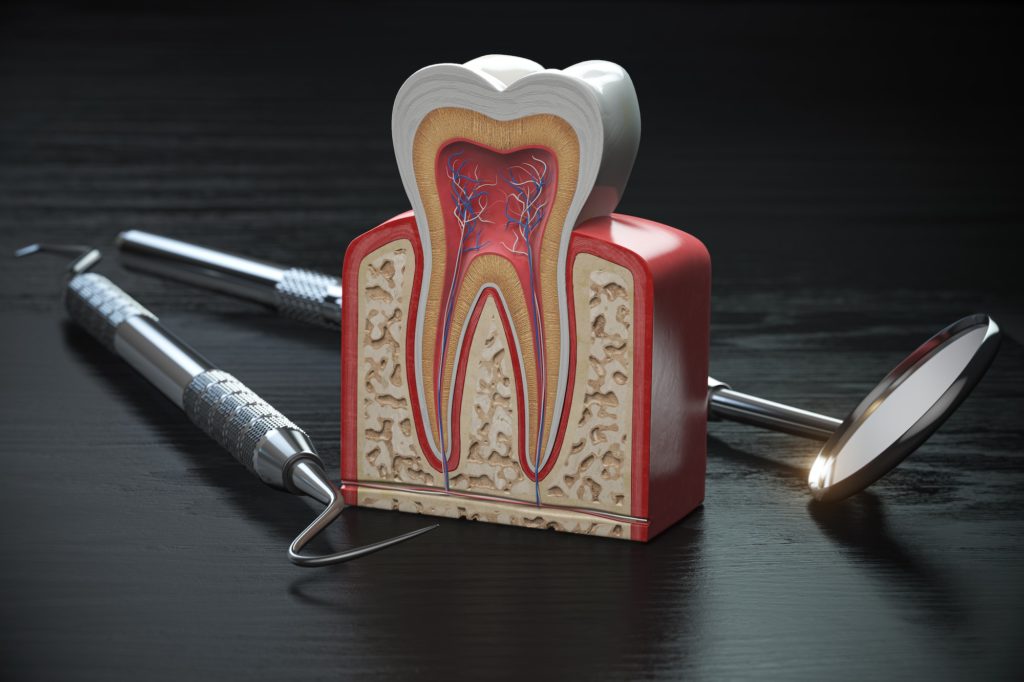What is a Dead Tooth?

Discover what a dead tooth is and what the options to treat this common dental issue are, and where to go for dental help for your dead tooth before it worsens.
Table of Contents
Do you think you or someone you know may have a dead tooth? The first thing you and others close to you will notice is the smell. Similar to fruits and vegetables you bought and never ate, your tooth gets rotten and starts to release a foul smell. Inside your mouth, you may have a rotten taste and pain. You may feel pain in the dying tooth or the gums surrounding the area, and the tooth may also become loose. Discoloration of your tooth will happen, affecting the pearly whites of your smile, since the dying tooth may be yellow, light brown, gray, or even black in appearance.
What is a Dead Tooth?
Many people don’t think of our teeth as living and just see them as bone, but your healthy teeth are “alive” and made up of hard and soft tissues. Your soft tissue is important for keeping your teeth healthy. The inner layer of your tooth is called your pulp, and if your pulp is damaged or decays, it stops circulating blood to your tooth. From there, your tooth becomes more susceptible to infections and could cause the nerve to die.
A number of things can cause a dead tooth. Trauma/injury to your tooth is a common cause for your tooth to die. Maybe you got hit by a pitch with a baseball or even face-planted teeth first on concrete (ouch); both injuries could possibly cause enough trauma on your nerve for your tooth to die. Your tooth can die quickly; sometimes, it’s only a few days. However, your tooth can die more slowly, which could be over several months or years.
Like most dental issues, a dead tooth can be caused by a lack of proper dental hygiene. Cavities that are left untreated can slowly destroy your tooth. Since cavities begin on the enamel (the outer protective layer of your tooth) when untreated, they slowly eat away at the enamel and reach the pulp. This will lead to your pulp becoming infected, cutting off blood to the pulp and, over time, causing it to die. Once the pulp starts decaying, you will likely be in pain.
What Does a Dead Tooth Look Like?
A dead tooth will often have discoloration or looks like it is bruised. Often you’ll notice a black or grayish tint on the tooth.
How Do You Treat a Dead Tooth?
- Root canal: If your tooth is intact, a root canal and a filling or crown may help keep your tooth functional. A root canal procedure gets rid of the dead pulp and replaces it with a plastic-like material. Since your dead tooth can become brittle, you may get a crown over the tooth after the root canal treatment to keep it strong and supported.
- Extraction: If your dead tooth is too damaged, it must be removed. During the procedure, your dentist will completely remove the whole tooth. After the extraction, you have a few options for replacement. You have the choice of an implant, dentures, or a bridge. It’s best to talk with your dentist about your options and see what’s best for your situation.
What to Do Before and After a Dead Tooth Root Canal?
For your dental hygiene, your breath, and other people’s noses it is best to get your dead tooth treated right away. Though not all dead tooth cases are preventable, practicing good dental hygiene by brushing twice daily, flossing, and rinsing with mouthwash will make it highly unlikely for your tooth to die. See your dentist every 6 months to prevent any untreated cavities from getting out of hand. If you’re playing sports, wear a mouthguard to prevent any trauma to your teeth. If you have a dead tooth, see a dentist to see what treatment is right for you and your smile.
Dead Tooth FAQs
Damage or infection to the pulp, the soft tissue inside the tooth that houses nerves and blood arteries, can result in the development of a dead tooth. If the damaged or diseased pulp is not treated, it may die, cutting off the tooth’s blood supply and resulting in discoloration. Untreated cavities, tooth trauma, and gum disease are common causes of pulp injury or infection. If you feel a tooth is dead, getting dental care right away is crucial because, if ignored, it can cause other oral issues.
The symptoms of a dead tooth can vary, but some common signs include discoloration, pain or sensitivity, and foul odors. Discoloration of the tooth can range from a dark grayish color to a yellow or brownish hue. The tooth’s progressive decay and lack of blood supply are the causes of this color.
When a tooth’s nerve dies or gets infected, it may experience pain or sensitivity, making it uncomfortable to chew or drink. The decaying tissue inside the tooth can also produce foul odors. If you have these symptoms, visiting a dentist to ascertain the cause and the best course of action is crucial.
A dead tooth can die due to damage or infection to the dental pulp, the soft tissue inside the tooth containing nerves and blood vessels. Numerous factors, such as untreated cavities, dental damage, or gum disease, can cause this. Damaged or infected dental pulp renders the tooth incapable of receiving oxygen and nutrients, leading to the death of the nerve and blood vessels.
Without an adequate blood supply, a tooth may grow weaker and more prone to cracking or shattering. It’s important to seek prompt dental care if you suspect a dead tooth, as the underlying cause needs to be treated to prevent further dental problems.
Preventing a dead tooth involves:
- Maintaining good oral hygiene practices, such as brushing twice daily with fluoride toothpaste.
- Flossing daily.
- Visiting your dentist regularly for check-ups and cleanings.
Additionally, it’s essential to protect your teeth from trauma by wearing a mouthguard during sports or other activities that could cause damage to your teeth If you experience tooth pain or sensitivity, seeking prompt dental care is important to prevent further damage or infection to the dental pulp. By taking these steps, you can help maintain healthy teeth and avoid the risk of a dead tooth.
